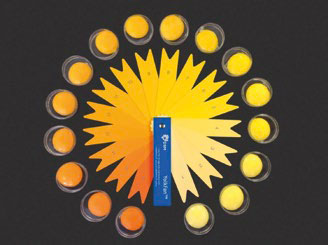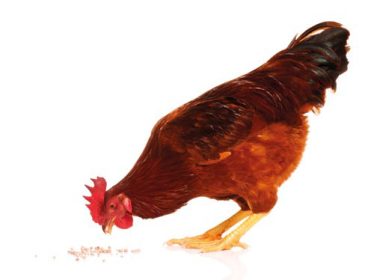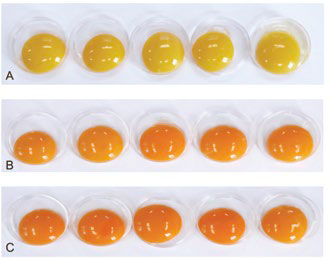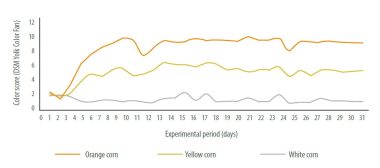
Of the largest egg-producing companies in Latin America, 50% are located in Brazil, accounting for just over 10% of all global production. In 2021, of the 55.5 billion eggs produced, 99.54% were destined for domestic consumption, demonstrating a significant increase in egg consumption, reaching 257 units of eggs per inhabitant. According to the report published by ABPA in 2023, between 2018 and 2022 the Brazilian population’s per capita egg consumption increased by just over 35%.
- The increase in egg consumption in 2021 may be related to the COVID-19 pandemic, which has led many consumers to look for more accessible and affordable sources of animal protein.
In situations of budget constraints, as has been the case during the pandemic, consumers tend to select foods with lower added value, which may explain the increase in demand for eggs.

Eggs are a source of protein with a high biological value that can be compared to breast milk in terms of nutritional composition, which means that a large part of all the amino acids that make up this food will be used efficiently by the body.
- As well as being a source of protein, eggs 2020). are also a source of unsaturated fatty acids, minerals and vitamins (Table 1).

Consumer choice is driven by intrinsic characteristics such as texture, appearance and aroma, by extrinsic product characteristics such as labeling and packaging, or by sociocultural factors such as habits, beliefs or trust in the production industry.
- Despite this, sensory properties such as shell, egg size and yolk color are the main characteristics that determine the consumer’s choice of product (Rondoni et al., 2020).
- The color of the yolk can vary from a pale yellow to an intense orange, and to determine this quickly, a practical tool can be used, which is to compare the color of the yolk in natura with a range of colors with a scale of 1 to 16 shades from yellow to orange (Figure 2).

Among the three sensory characteristics mentioned above, we will discuss in the course of this technical material the use of some natural ingredients in poultry feed and their effect on yolk coloration.
Among various compounds of plant origin, carotenoids are fat-soluble substances which, in addition to their pigmenting capacity, are also precursors of vitamin A, protect cells against oxidative stress and improve the performance of the immune system (Bendich & Olson, 1989; Rios et al., 2012).
Sources of xanthophyll carotenoids can be natural, such as corn and red peppers, or synthetic, such as 10% canthaxanthin (red pigment) or beta apo-8-carotene ethyl ester (Garcia et al., 2002).
- Carotenoids are widely used in the food, pharmaceutical and cosmetics industries for humans, as well as in the feed industry (Valduga, 2009).
An example of its application in animal nutrition is its use as an additive in layer poultry farming, with the xanthophylls group being the most widely used, since they are absorbed and accumulated in the body, thus modifying the color of the egg yolk.
Transport and absorption of carotenoids
The absorption metabolism of carotenoids takes place in the presence of bile salts, in the form of fat droplets, which are transformed into micelles in the lumen of the intestine (Parker, 1996).

With the help of lipoproteins in the cell membrane, the carotenoid, which has already been absorbed, accumulates in fat-rich cells and is consequently deposited in the egg yolk (Pérez-Vendrell et al., 2001).
Transport and absorption will depend on the type of carotenoid, the amount provided in the diet and the basic content of pigments present in the sources used to formulate these animals’ diets (Maia, 2020).
Natural sources of carotenoids
Annatto (Bixa orellana L.)
Among the plant species rich in carotenoids is annatto, the fruit of the annatto tree, a small tree widely distributed throughout tropical America.
- Its seed, used ground, is rich in coloring substances called bixin, norbin and nobixate, and is used to produce colorifices (Fabri & Teramoto, 2015).
- The use of annatto flour as an alternative to modify the color of laying eggs is a strategy that has already been used in several studies, such as Silva et al. (2000) who used six levels of annatto oil extract inclusion in laying rations using sorghum as the main source of energy, compared to a cornbased diet.
- The authors reported that the inclusion of 0.1% Urucum extract in sorghumbased feed promoted similar yolk pigmentation when compared to layers fed corn-based feed.
In a recent study, Martínez et al. (2021) evaluated 3 levels of inclusion of annatto powder in the dietof layers (0.5%, 1.0% and 1.5%) for 56 days on the external characteristics of eggs, such as egg weight, resistance and shell thickness, and internal characteristics such as albumen height, Haugh unit and color of the yolk. The authors reported that of all qualitative attributes that were influenced by the inclusion of Urucum powder, the color of the yolk was affected in a more expressive way.
- These studies show that the use of annatto as an alternative to change the the tone of the yolk is effective and strategy to produce eggs with a different color, more orange than conventional eggs.
Marigold petal extract (Tagetes erecta L.)
Marigold is a flower belonging to the Asteraceae herb family and is native to North, Tropical and South America. It is currently the only flower marketed as a source of carotenoids (xanthophylls, zeaxanthin, lutein) and other compounds such as flavonoid (Hadden et al., 1999).
The use of Marigold petal extract is feasible when the diet contains low levels of xanthophylls, such as diets based on sorghum, millet and wheat.
- In the study by Oliveira et al. (2017), the authors evaluated the inclusion of paprika and Marigold extract in sorghum-based diets for light layers and found that the addition of these natural pigments changed the color of the yolk.
- For Japanese quail, there are studies, such as the one developed by Moura et al., (2011), which investigated how the inclusion of Marigold petal in a sorghum-based diet could change the color of egg yolks.
- The authors reported that the use of the extract was effective and resulted in a yolk colorimetric score equivalent to that of other quails fed corn-based diets.
Paprika extract
- Paprika is obtained through grinding of dehydrated fruits bell pepper (Capsicum annuum).
The fruit must be fully ripe for the carotenoid pigments such as capsanthin, capsorubin, carotene, cryptoxanthin and zeaxanthin are present (Henz & Ribeiro, 2008). Among the pigments, capsanthin represents 50 to 70% of the xanthophylls present in paprika, thus giving the pigment a red-orange color (Marçal, 2021).
- The compounds present in paprika extract are effective pigmenting substances for modifying the color of egg yolks (Ribeiro et al., 2012), but they are more expensive than other sources.
- When comparing the inclusion of paprika extract alone or in combination with Marigold petal extract, Lokaewmanee et al. (2010) reported that the yolk coloration of layers fed a corn-based control diet (without added pigment) was paler compared to the yolk of birds fed 0.1% paprika extract.
- However, when paprika and marigold extracts were used in combination, including 0.1% of each, the intensification of the yolk’s orange hue was more pronounced, as shown in Figure 5.
- This shows that the use of paprika, whether or not combined with the Marigold petal, can intensify the color of the yolk.

- Similarly, when evaluating the inclusion of paprika extract and Marigold for light layers fed a sorghum-based diet, Oliveira et al. (2017) observed that 0.6% paprika extract was effective in modifying yolk coloration so that it reached score 14 in the colorimetric range.
- However, the authors did not observe significant effect on coloring of the yolk when the birds were fed with the two pigments, therefore, concluding that paprika extract is effective for intensify the color of the yolk regardless of the presence or absence of the use of Marigold extract.
Turmeric powder extract
- Turmeric or saffron (Curcuma longa L.) belongs to the same ginger family and is commonly used in cooking because it has a slightly bitter/peppery taste and for having a citrus fragrance. In addition to the known sensory characteristics of this spice, its use as pigment additive has already been demonstrated in poultry diets.
- Turmeric powder supplementation for 7 weeks was able to intensify egg yolk coloration in layers as shown by Park et al., (2012), the authors used levels of 0.10%, 0.25% and 0.50% and obtained an effect on yolk coloration already with the lowest level of turmeric inclusion.
This same effect was observed by Hadj Ayed et al. (2018) when evaluating the inclusion of turmeric powder for layers at dosages of 0.5, 1.0, 1.5 and 2.0%, yolk coloration intensified linearly for birds fed turmeric powder ranging from 7.81 to 9.19 compared to the calorimetry range.
In addition to its function as a pigment, turmeric may have an effect on the intestinal health of broilers challenged with Eimeria.
- A study by Gogoi et al. (2019) showed that animals supplemented with turmeric powder (200mg/kg of feed), showed less deposition of oocysts and a reduction in intestinal lesions (Yadav et al., 2020).
Corn grain
- Corn is an ingredient widely used as a source of energy in poultry diets. Although it has a lower concentration of carotenoids compared to other foods, it is considered a source of this class of pigmenting substances (Fassani et al., 2019).
The endosperm of the grain contains carotenoids classified as xanthophylls (lutein, β-cryptoxanthin and zeaxanthin) and carotenes (β-carotene, α-carotene and β-ζ- carotene) (Janick-Buckner et al., 1999).
According to Fassani et al. (2019), the levels of carotenoids present in corn vary according to the strains, cultivars, maturity stage, climate, production site and even environmental conditions during harvest.
Corn hybrids have variable carotenoid composition, Kljak et al. (2021) investigated five commercial hybrids in diets of laying hens reared in a conventional system and evaluated yolk color after 10 weeks of consumption of experimental diets containing only corn hybrids as a pigment source.
- The authors found that birds fed with the richest hybrid in carotenoids, mainly in zeaxanthin (9.99μg) and β-carotene (1.74μg), presented a score of yolk color of 10.8 as per described on the coloring range scale.
The choice of corn hybrid can be a strategy to modify and intensify the color of the yolk produced by birds reared in a conventional system, and it is a financially more advantageous alternative since there is no need to use other pigment additives in the diet.
- Currently it is possible to find the biofortified corn, which is a product obtained through genetic improvement, having in its composition modified β-carotene.

- Recently, Ortiz et al. (2021) evaluated the use of a biofortified hybrid enriched in carotenoids for 32-weekold layers fed for 31 days of production.
- The authors verified that the coloring of the yolk was more intense for birds fed as modified hybrid called as orange, compared to the corn hybrid common yellow and white, from the 4th day onwards receiving the
experimental diet (Figure 6).
CONCLUSIONS
- The color of the yolk is an attribute that consumers take into account when making a purchase, often looking for eggs with darker shells and/ or yolks, believing that this colorful product has more nutrients and is tastier.
- The use of natural pigments is an alternative to intensify the coloration of the yolk of laying birds, and the studies carried out to date show that these pigments have a significant capacity to modify coloration, as well as conferring other advantages such as improving the health and intestinal integrity of the birds.
Source: avinews.com







